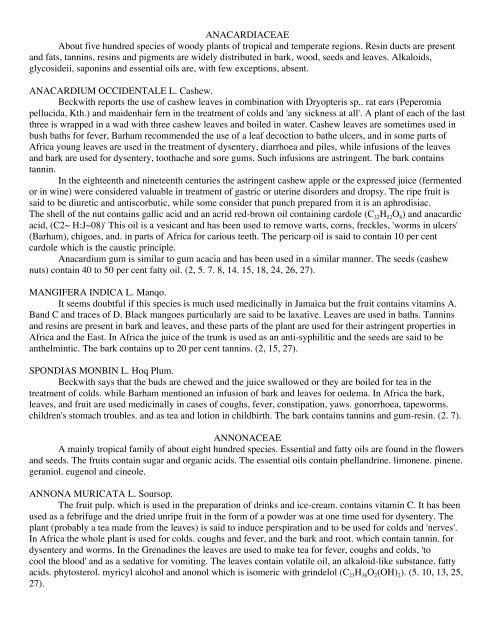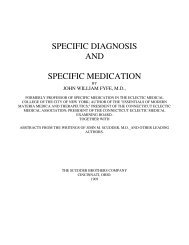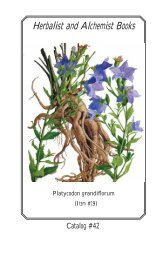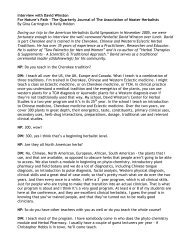MEDlCINAL PLANTS OF JAMAICA. PARTS 1 & 11.
MEDlCINAL PLANTS OF JAMAICA. PARTS 1 & 11.
MEDlCINAL PLANTS OF JAMAICA. PARTS 1 & 11.
You also want an ePaper? Increase the reach of your titles
YUMPU automatically turns print PDFs into web optimized ePapers that Google loves.
ANACARDIACEAE<br />
About five hundred species of woody plants of tropical and temperate regions. Resin ducts are present<br />
and fats, tannins, resins and pigments are widely distributed in bark, wood, seeds and leaves. Alkaloids,<br />
glycosideii, saponins and essential oils are, with few exceptions, absent.<br />
ANACARDIUM OCCIDENTALE L. Cashew.<br />
Beckwith reports the use of cashew leaves in combination with Dryopteris sp.. rat ears (Peperomia<br />
pellucida, Kth.) and maidenhair fern in the treatment of colds and 'any sickness at all'. A plant of each of the last<br />
three is wrapped in a wad with three cashew leaves and boiled in water. Cashew leaves are sometimes used in<br />
bush baths for fever, Barham recommended the use of a leaf decoction to bathe ulcers, and in some parts of<br />
Africa young leaves are used in the treatment of dysentery, diarrhoea and piles, while infusions of the leaves<br />
and bark are used for dysentery, toothache and sore gums. Such infusions are astringent. The bark contains<br />
tannin.<br />
In the eighteenth and nineteenth centuries the astringent cashew apple or the expressed juice (fermented<br />
or in wine) were considered valuable in treatment of gastric or uterine disorders and dropsy. The ripe fruit is<br />
said to be diuretic and antiscorbutic, while some consider that punch prepared from it is an aphrodisiac.<br />
The shell of the nut contains gallic acid and an acrid red-brown oil containing cardole (C 32H 52O 8) and anacardic<br />
acid, (C2~ H:J~08)' This oil is a vesicant and has been used to remove warts, corns, freckles, 'worms in ulcers'<br />
(Barham), chigoes, and. in parts of Africa for carious teeth. The pericarp oil is said to contain 10 per cent<br />
cardole which is the caustic principle.<br />
Anacardium gum is similar to gum acacia and has been used in a similar manner. The seeds (cashew<br />
nuts) contain 40 to 50 per cent fatty oil. (2, 5. 7. 8, 14. 15, 18, 24, 26, 27).<br />
MANGIFERA INDICA L. Manqo.<br />
It seems doubtful if this species is much used medicinally in Jamaica but the fruit contains vitamins A.<br />
Band C and traces of D. Black mangoes particularly are said to be laxative. Leaves are used in baths. Tannins<br />
and resins are present in bark and leaves, and these parts of the plant are used for their astringent properties in<br />
Africa and the East. In Africa the juice of the trunk is used as an anti-syphilitic and the seeds are said to be<br />
anthelmintic. The bark contains up to 20 per cent tannins. (2, 15, 27).<br />
SPONDIAS MONBIN L. Hoq Plum.<br />
Beckwith says that the buds are chewed and the juice swallowed or they are boiled for tea in the<br />
treatment of colds. while Barham mentioned an infusion of bark and leaves for oedema. In Africa the bark,<br />
leaves, and fruit are used medicinally in cases of coughs, fever, constipation, yaws. gonorrhoea, tapeworms.<br />
children's stomach troubles. and as tea and lotion in childbirth. The bark contains tannins and gum-resin. (2. 7).<br />
ANNONACEAE<br />
A mainly tropical family of about eight hundred species. Essential and fatty oils are found in the flowers<br />
and seeds. The fruits contain sugar and organic acids. The essential oils contain phellandrine. limonene. pinene.<br />
geraniol. eugenol and cineole.<br />
ANNONA MURICATA L. Soursop.<br />
The fruit pulp. which is used in the preparation of drinks and ice-cream. contains vitamin C. It has been<br />
used as a febrifuge and the dried unripe fruit in the form of a powder was at one time used for dysentery. The<br />
plant (probably a tea made from the leaves) is said to induce perspiration and to be used for colds and 'nerves'.<br />
In Africa the whole plant is used for colds. coughs and fever, and the bark and root. which contain tannin. for<br />
dysentery and worms. In the Grenadines the leaves are used to make tea for fever, coughs and colds, 'to<br />
cool the blood' and as a sedative for vomiting. The leaves contain volatile oil, an alkaloid-like substance. fatty<br />
acids. phytosterol. myricyl alcohol and anonol which is isomeric with grindelol (C 23H 36O 2(OH) 2). (5. 10, 13, 25,<br />
27).







